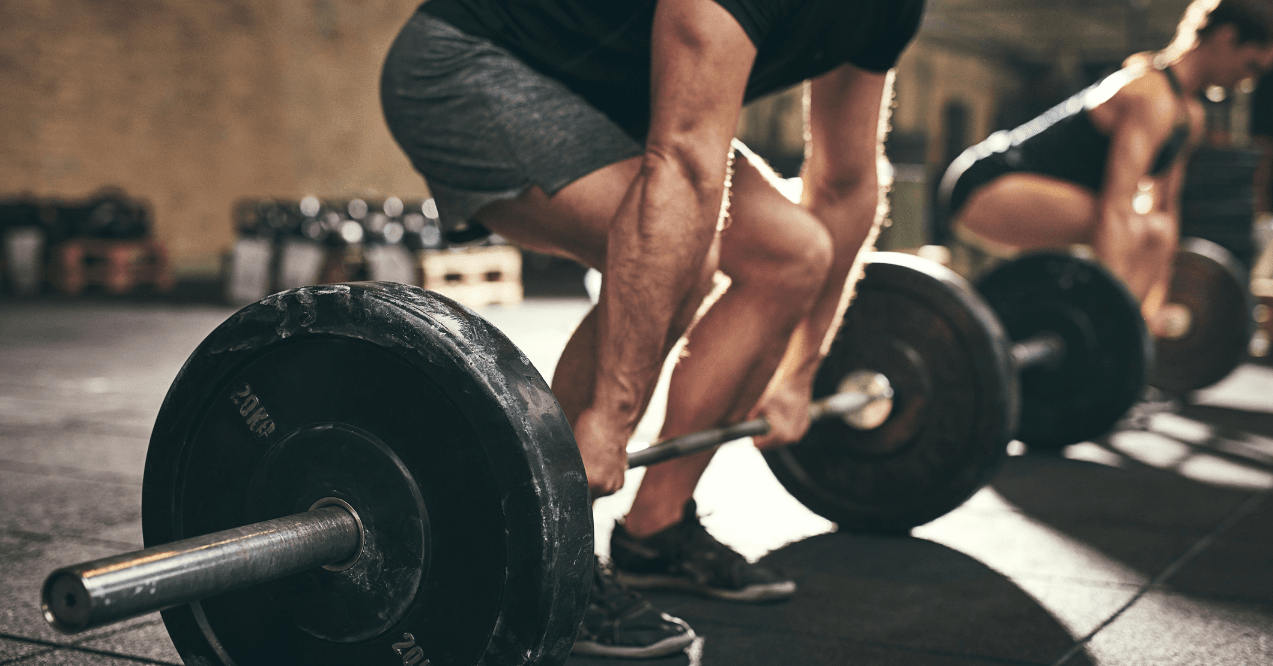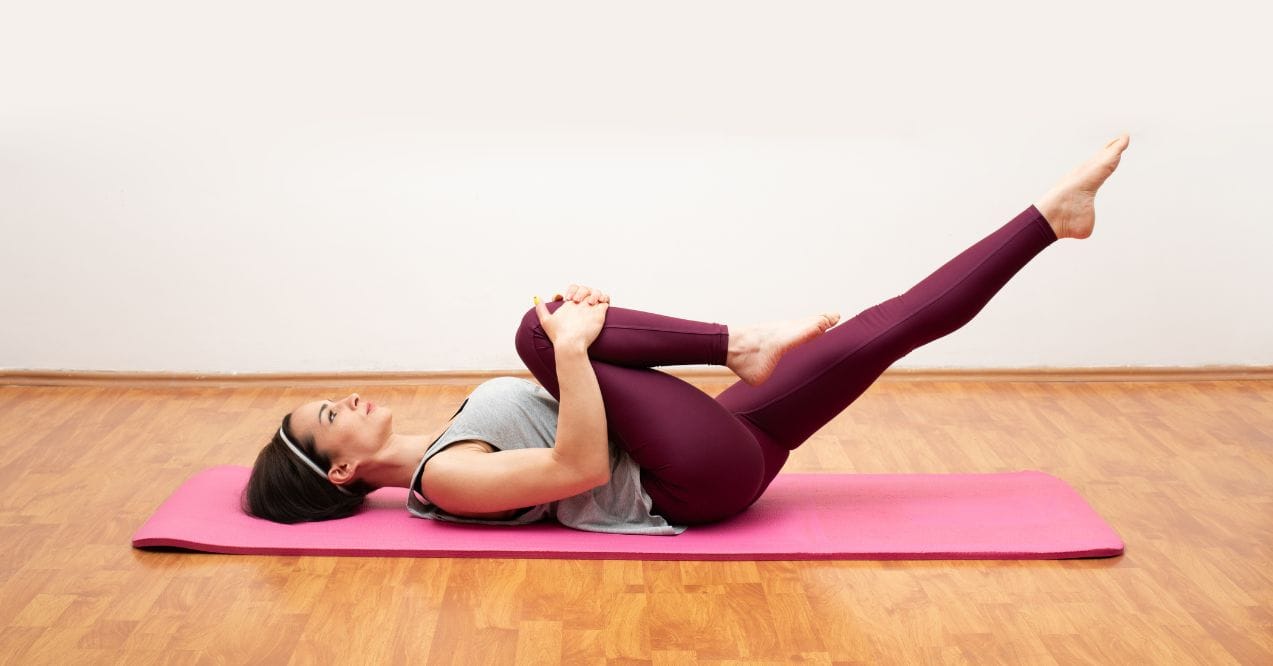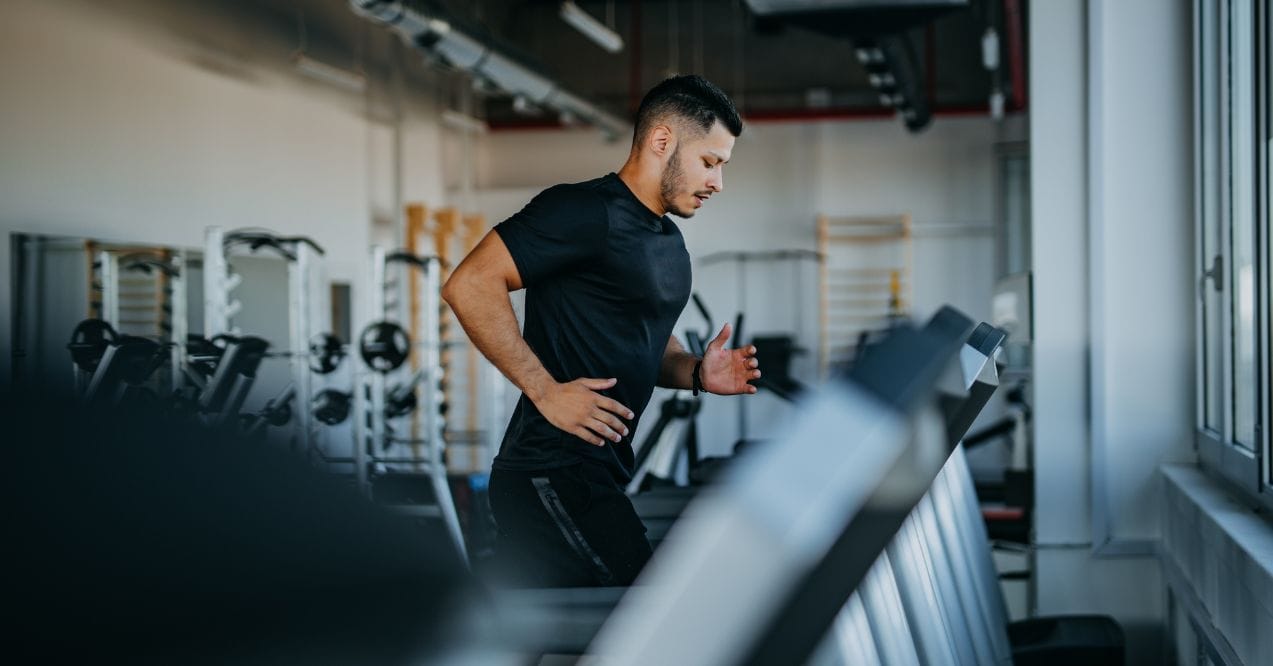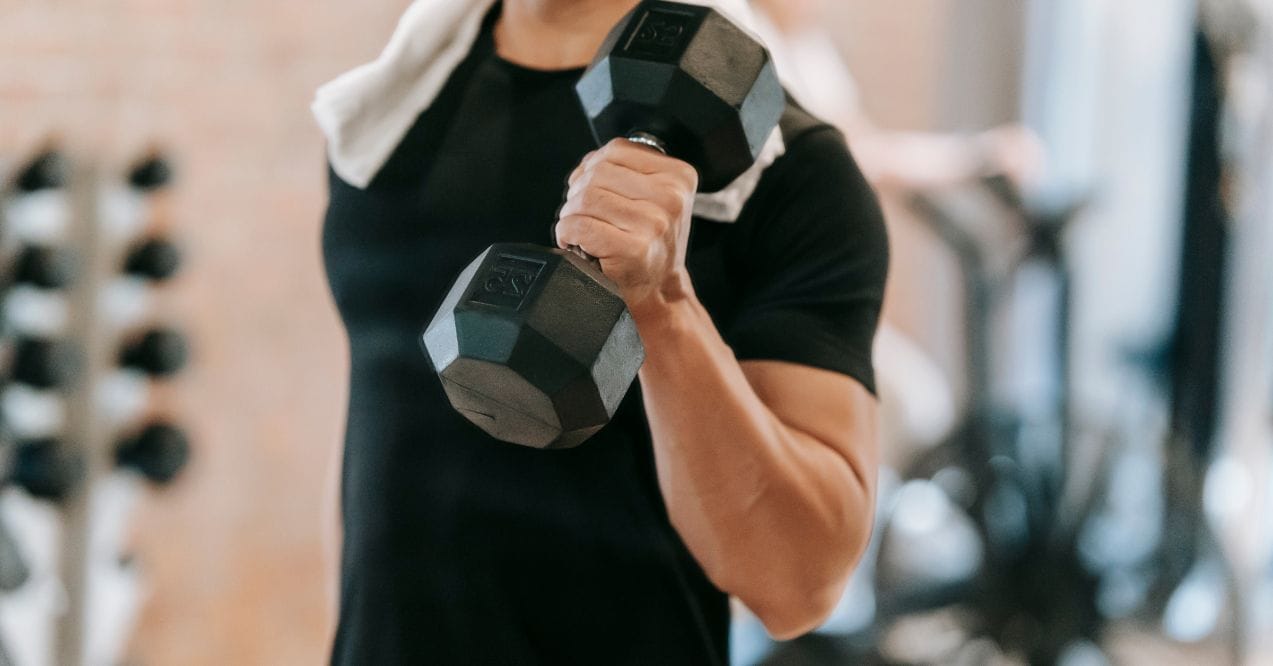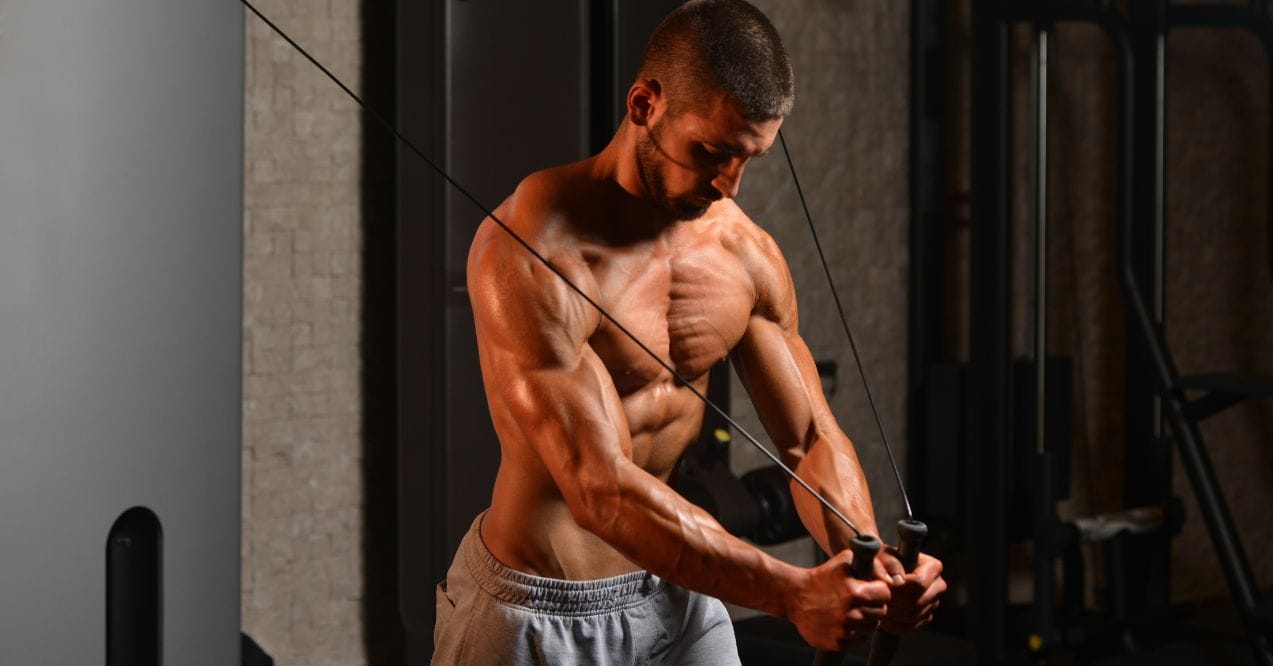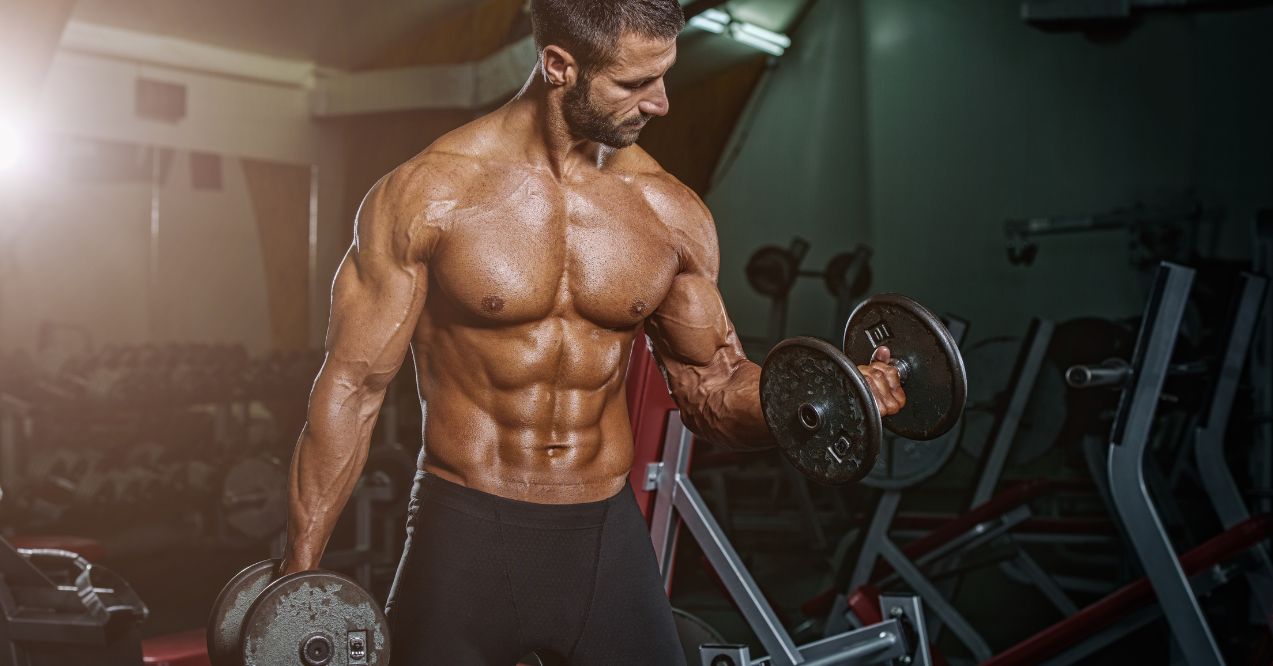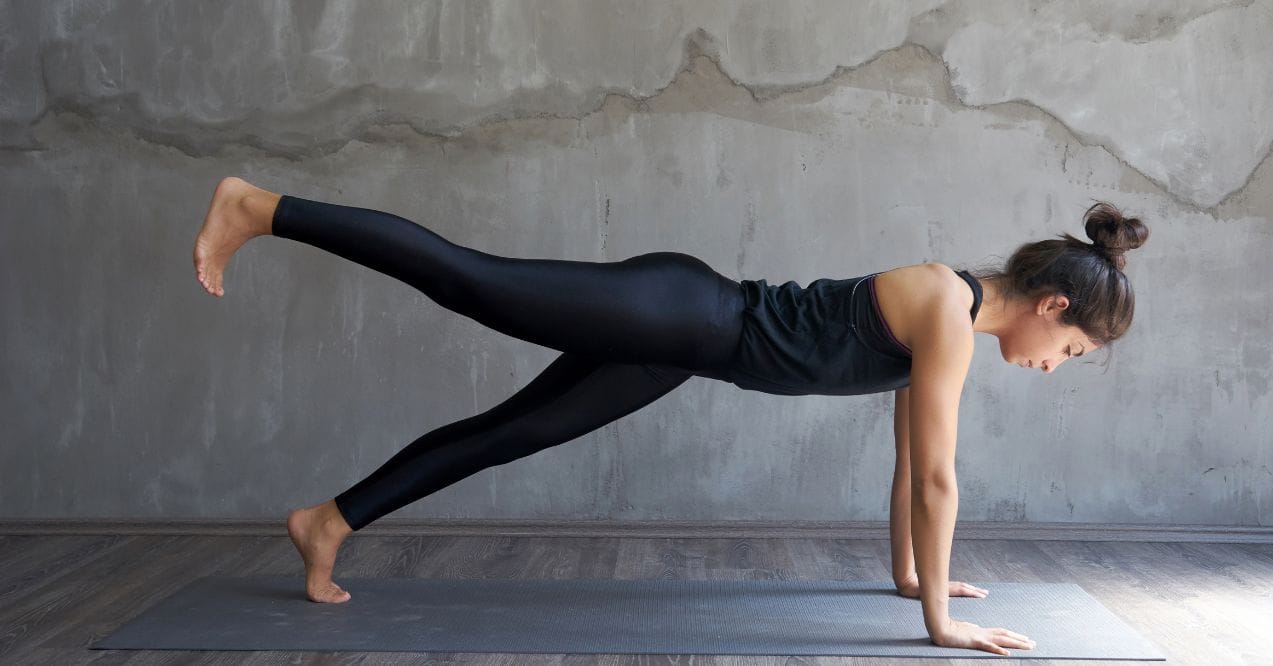Push Yourself to New Limits with the 28 Day Calisthenics Challenge
The 28 day calisthenics challenge stands as a transformative program designed to reshape your fitness journey through bodyweight exercises. This comprehensive guide takes you through a structured approach to building strength, improving mobility, and achieving better overall fitness without the need for complex equipment.

What Are the Benefits of Calisthenics?
The power of calisthenics lies in its versatility and effectiveness. As you explore What is Body Recomposition, you’ll find that calisthenics plays a vital role in simultaneously building muscle and reducing body fat percentage. This training method offers unique advantages that make it an excellent choice for anyone looking to improve their fitness level.
Requires Little to No Equipment
One of the main appeals of calisthenics is its accessibility. You don’t need an expensive gym membership or sophisticated equipment to get started. Your body becomes the primary tool for building strength and improving fitness. This makes the free 28 day workout challenge particularly appealing for those who want to start their fitness journey without financial barriers.
Improves Brain-Body Connection
Working on balance in calisthenics develops a strong mind-muscle connection. Each movement pattern requires focus and control, leading to improved coordination and body awareness. This enhanced connection helps in daily activities and carries over to other forms of exercise.
Helps You Build Strength Effectively
The list of calisthenics exercises includes compound movements that engage multiple muscle groups simultaneously. These movements create functional strength that translates directly to real-world activities. Pull-ups, push-ups, and squats build practical strength that you can use in everyday life.
Gentler on Joints
Unlike traditional weight training, calisthenics allows for natural movement patterns that put less stress on your joints. The progressive nature of bodyweight exercises lets you build strength while maintaining joint health. This makes calisthenics suitable for long-term training without the wear and tear often associated with heavy weight lifting.
28-Day Calisthenics Challenge Schedule
The 28 day calisthenics challenge follows a structured weekly rotation that targets different aspects of fitness. Each workout integrates Time Under Tension Workout principles to maximize muscle engagement and growth. Let’s break down the daily focus areas and progression strategy.
Day 1: Upper Body
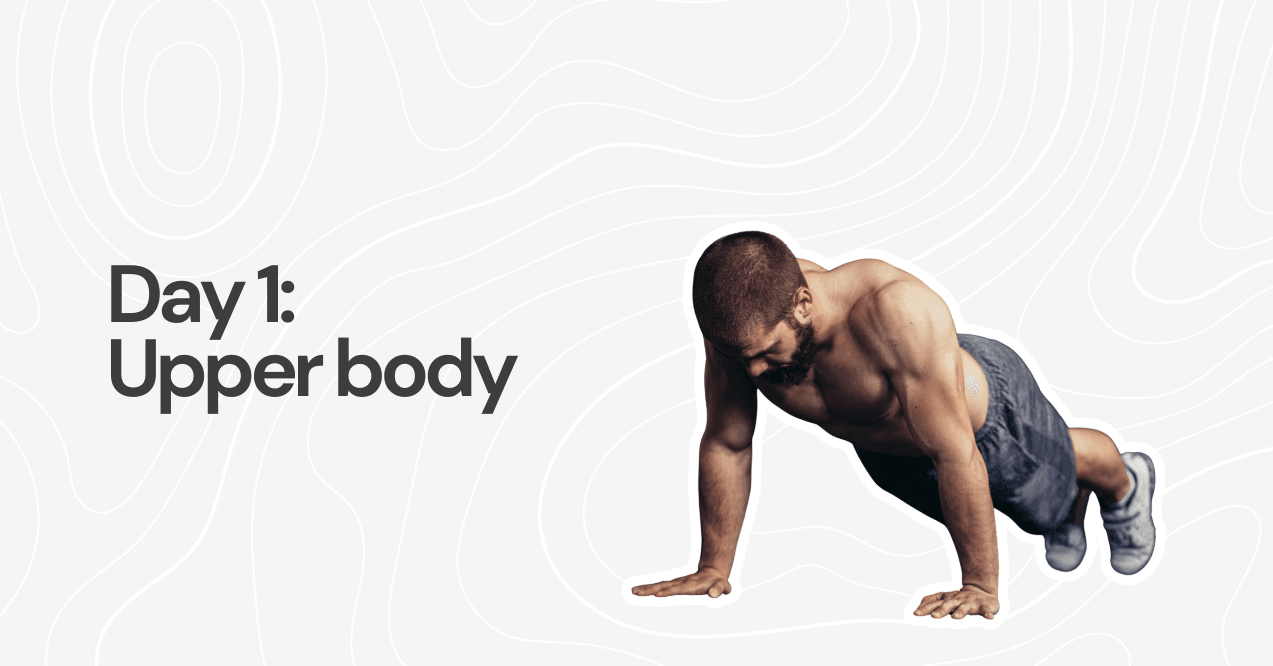
The chest and tricep workout forms the foundation of your upper body training. Each exercise focuses on proper form and controlled movement:
Push-ups: 4 sets x 10-12 reps
- Standard grip for overall chest development
- Focus on full range of motion
- Keep core engaged throughout
Pull-ups/Chin-ups: 4 sets x 6-8 reps
- Alternate between wide and narrow grip
- Emphasize controlled descent
- Scale with assisted variations if needed
Pike Push-ups: 3 sets x 8-10 reps
- Target shoulder strength
- Progress to wall handstand holds
- Maintain straight body alignment
Diamond Push-ups: 3 sets x 8-12 reps
- Focus on tricep engagement
- Keep elbows close to body
- Control the downward phase
Day 2: Cardio + Abs

This session combines high-energy movements with core stability work:
Mountain Climbers: 4 sets x 30 seconds
- Maintain plank position
- Alternate legs at moderate pace
- Focus on hip mobility
Plank Variations: 3 sets x 45 seconds each
- Standard plank
- Side planks
- Reverse plank
Bicycle Crunches: 3 sets x 20 reps per side
- Control rotation movement
- Keep lower back pressed down
- Focus on oblique engagement
Burpees: 4 sets x 10 reps
- Full body movement
- Add push-up for intensity
- Scale by removing jump
Day 3: Lower Body
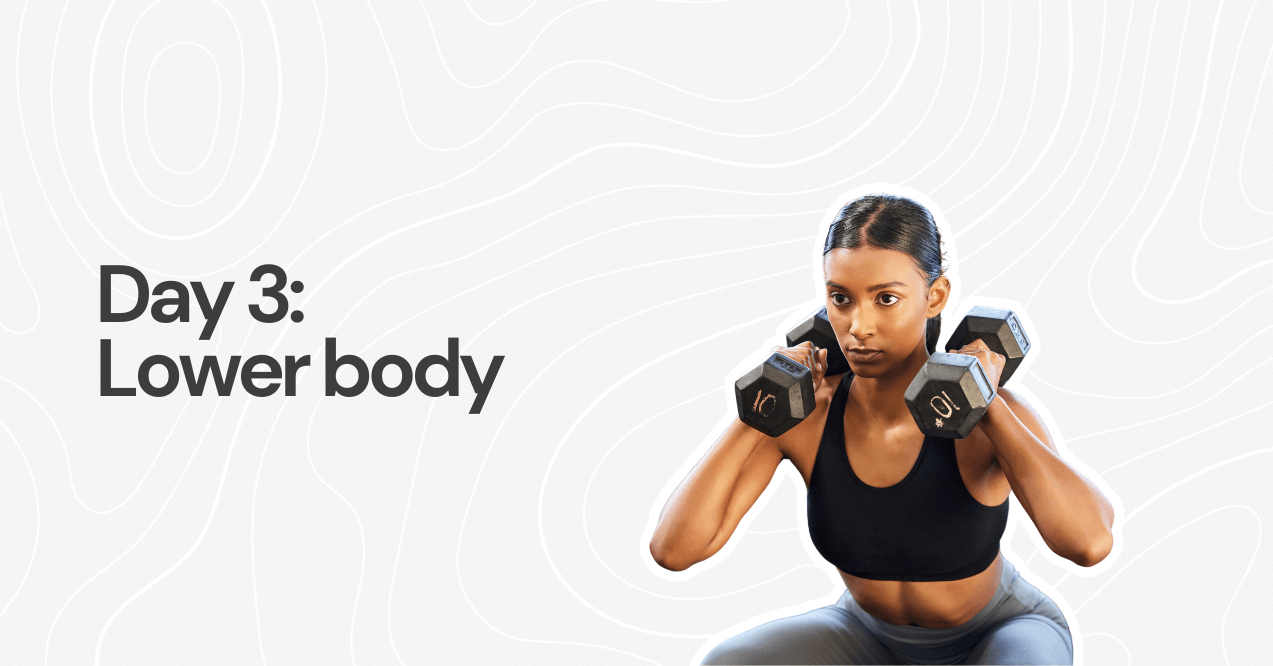
Lower body strength forms the base of your functional fitness:
Bodyweight Squats: 4 sets x 15-20 reps
- Focus on depth and form
- Keep chest up throughout
- Drive through heels
Walking Lunges: 3 sets x 12 steps each leg
- Maintain upright posture
- Take full steps
- Control knee position
Jump Squats: 3 sets x 10 reps
- Land softly
- Maintain form under fatigue
- Focus on explosive power
Single-Leg Glute Bridges: 3 sets x 12 reps each side
- Full hip extension
- Hold peak contraction
- Keep core engaged
Day 4: HIIT
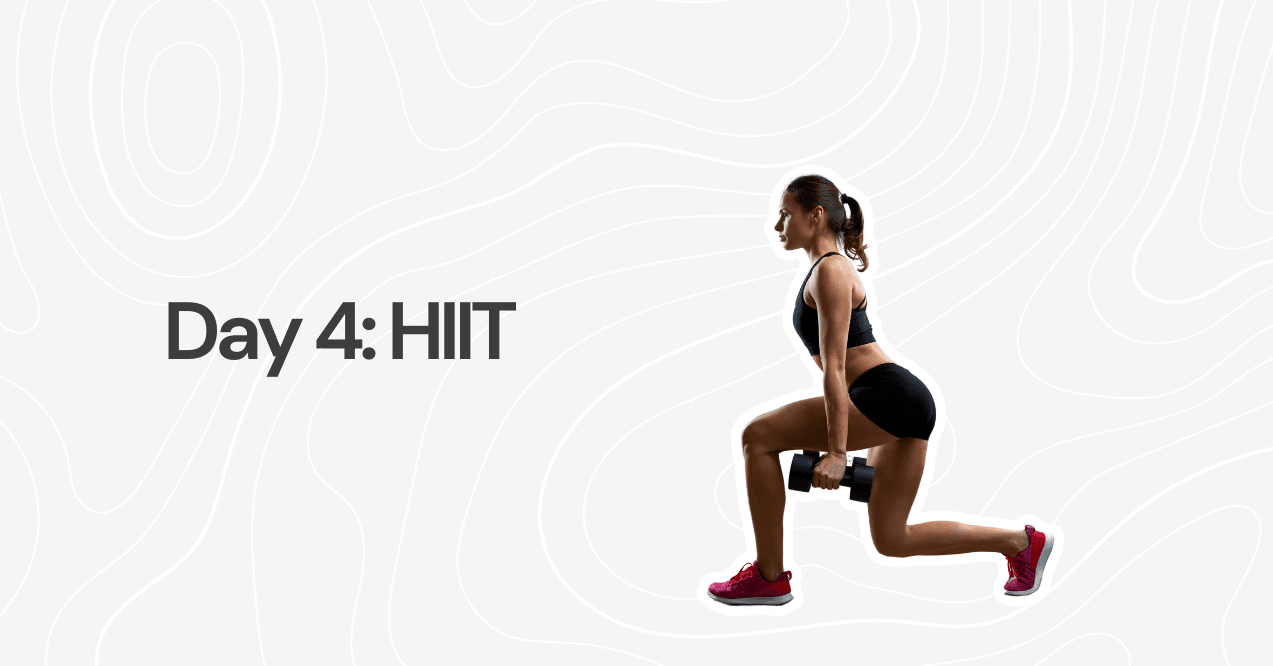
High-Intensity Interval Training maximizes fat burning and cardiovascular fitness. This session follows a structured interval format with specific work-to-rest ratios:
High Knees: 4 sets x 30 seconds
- Drive knees toward chest
- Land on balls of feet
- Maintain upright posture
- Engage core throughout
Jump Lunges: 4 sets x 30 seconds
- Start in split stance
- Jump and switch legs mid-air
- Land softly with bent knees
- Keep torso stable
Mountain Climbers: 4 sets x 30 seconds
- Start in plank position
- Drive knees alternately
- Keep hips level
- Maintain steady pace
Squat Jumps: 4 sets x 30 seconds
- Start in squat position
- Explode upward
- Land softly in squat
- Control each landing
Format Details
- 30 seconds active work
- 30 seconds rest between exercises
- 2 minutes rest between rounds
- Complete 4 full rounds
Day 5: Upper Body
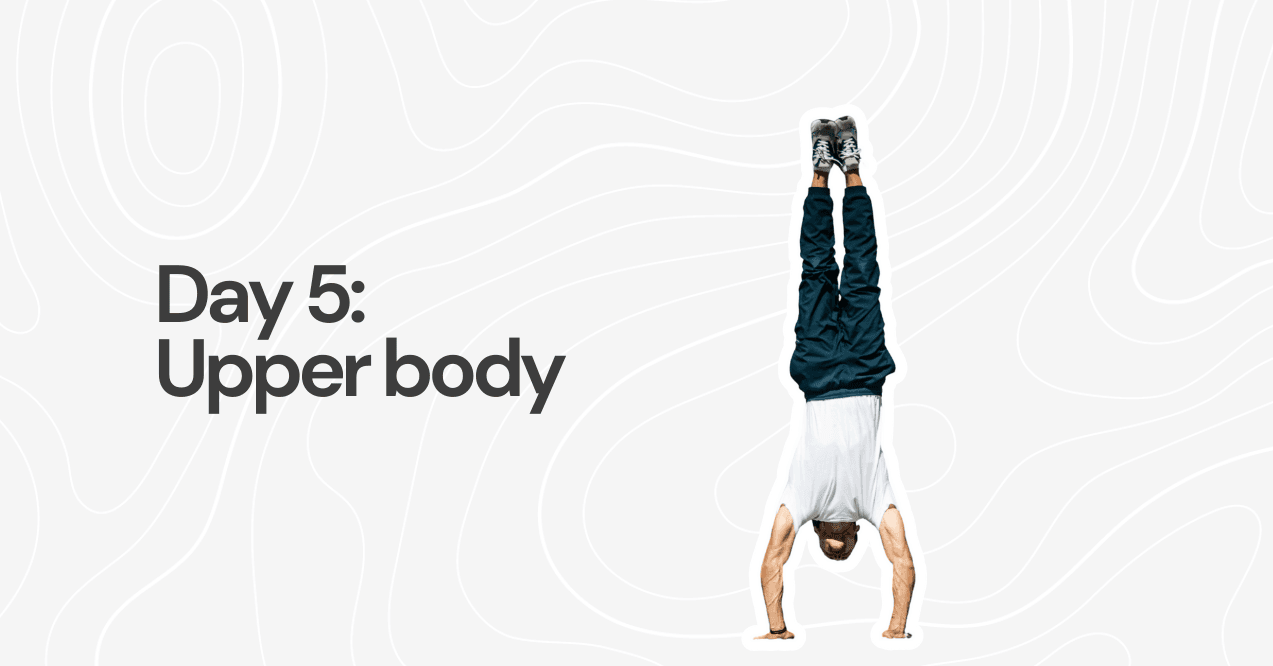
This session emphasizes controlled movements and time under tension for upper body development:
Wide Push-ups: 4 sets x 12 reps
- Hands wider than shoulders
- Keep elbows at 45-degree angle
- Full range of motion
- 2-second lowering phase
Inverted Rows: 4 sets x 10 reps
- Body straight and tight
- Pull shoulder blades together
- Touch chest to bar
- Control descent
Dips: 3 sets x 8-10 reps
- Lock out arms at top
- Lower until arms parallel
- Keep shoulders down
- Control body lean
Wall Handstand Hold: 3 sets x 20-30 seconds
- Start with pike position
- Walk feet up wall
- Stack shoulders over hands
- Engage core throughout
Day 6: Lower Body
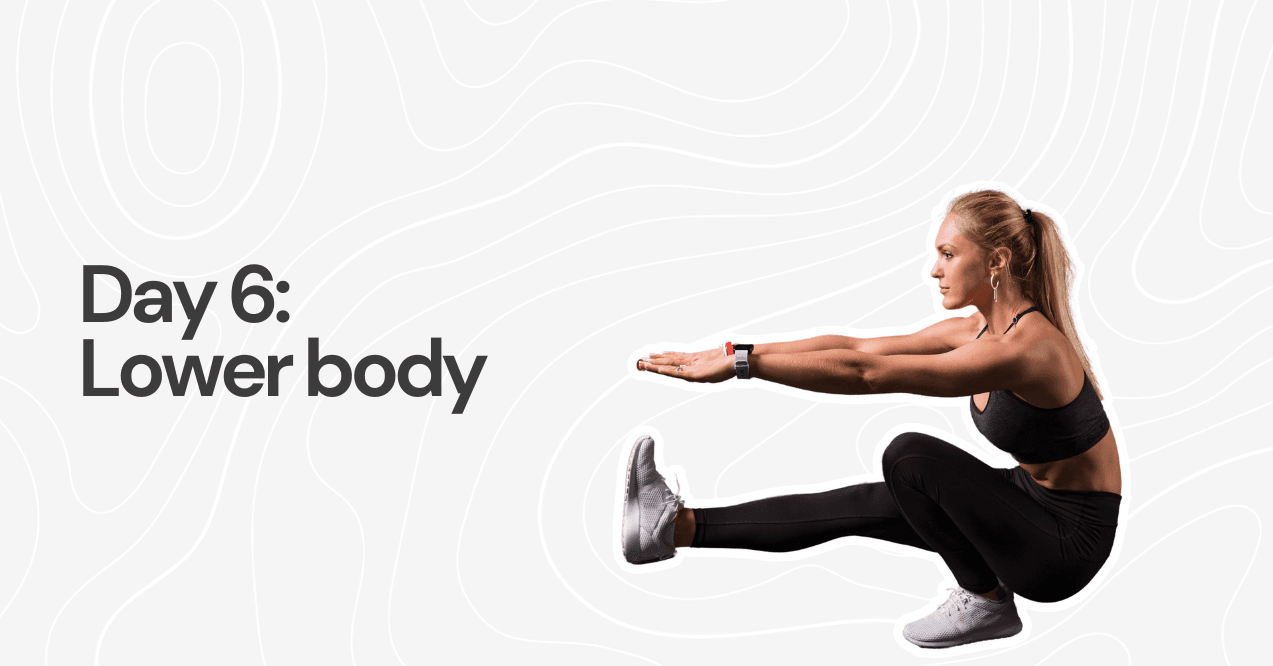
The second lower body session introduces advanced variations to challenge stability and power:
Jump Lunges: 4 sets x 10 reps each leg
- Start in split stance
- Alternate legs explosively
- Land softly each time
- Maintain forward gaze
Pistol Squat Progressions: 3 sets x 5 reps each leg
- Begin with support hold
- Lower with control
- Keep non-working leg straight
- Drive through heel to stand
Box Jumps: 4 sets x 8 reps
- Start at appropriate height
- Jump from quarter squat
- Land softly in squat
- Step down between reps
Wall Sits: 3 sets x 45 seconds
- Back flat against wall
- Thighs parallel to ground
- Knees over ankles
- Active foot press
Day 7: Mobility + Flexibility
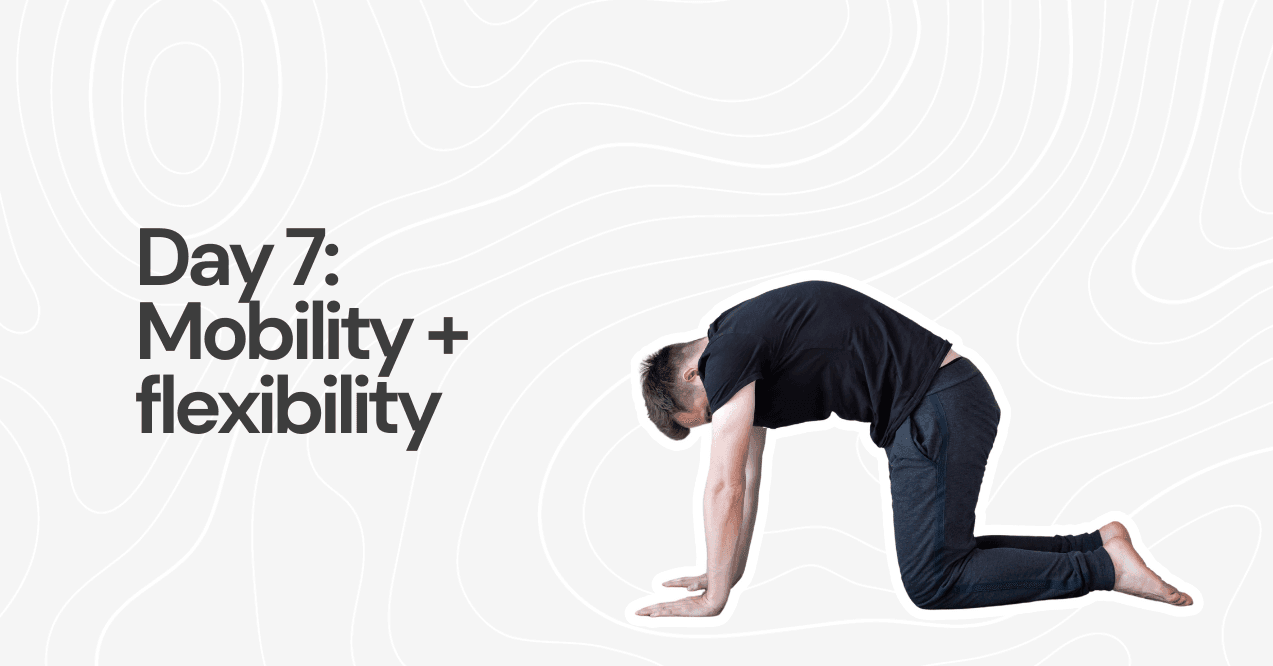
Recovery and mobility work focuses on releasing tension and improving range of motion:
Cat-Cow Stretches: 2 minutes
- Flow between positions
- Focus on spinal articulation
- Coordinate with breath
- Move through full range
Downward Dog to Cobra Flow: 10 repetitions
- Press hands firmly
- Draw shoulders down
- Engage core in transitions
- Move with control
World’s Greatest Stretch: 5 reps each side
- Start in lunge position
- Rotate toward front leg
- Keep back leg straight
- Hold each position
Hip Flexor Stretches: 1 minute each side
- Find proper alignment
- Tuck pelvis under
- Engage glutes
- Breathe deeply
Shoulder Mobility Work: 5 minutes total
- Include arm circles
- Band pull-aparts
- Wall slides
- Scapular retractions
What Equipment Do You Need for This Calisthenics Challenge?
The free 28 day workout challenge requires minimal equipment, making it accessible for most people. Here’s what you’ll need:
Essential Items
- Exercise mat or soft surface for floor work
- Sturdy chair or bench for dips
- Pull-up bar or sturdy overhead beam
- Timer for tracking intervals
- Water bottle for hydration
Optional Items
- Resistance bands for assistance and added difficulty
- Parallettes for advanced push-up variations
- Yoga blocks for mobility work
- Jump rope for cardio alternatives
How to Progress During the 28-Day Workout Challenge
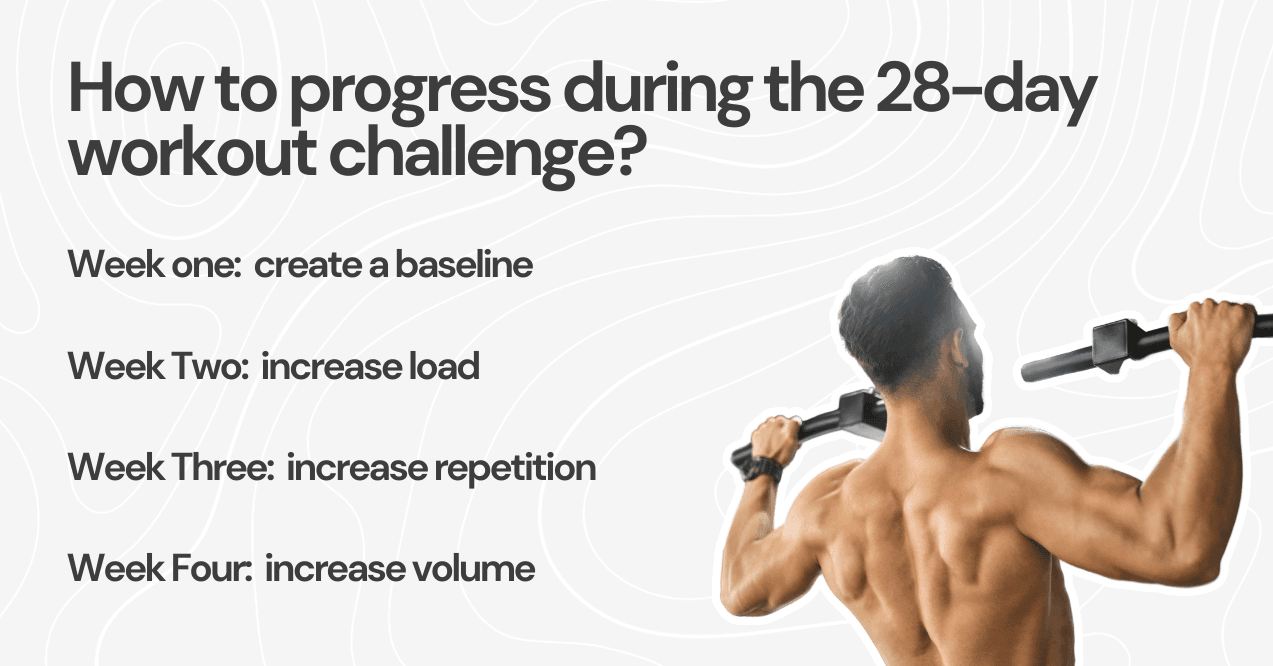
Working on balance in calisthenics involves strategic progression through each week. The key lies in making small, manageable adjustments that build upon your previous achievements.
Week One: Create A Baseline
Your first week serves as the foundation for the entire program. This initial phase prioritizes proper form and movement patterns over intensity or volume. Start by performing each exercise with deliberate control, focusing on the mind-muscle connection and proper breathing patterns.
During this week, document your baseline performance for each exercise:
- Maximum repetitions with good form
- Time under tension capabilities
- Rest periods needed
- Energy levels during workouts
The technical aspects of each movement deserve special attention. Take time to film yourself or practice in front of a mirror to ensure proper alignment and execution. Your focus should extend beyond the exercises themselves to include proper breathing patterns and recovery strategies.
Week Two: Increase Load
Building upon your established foundation, week two introduces strategic intensity increases. This progression doesn’t rely on external weights but rather on manipulating exercise variables to create additional challenge.
Your body adapts quickly to new stimuli, so these adjustments maintain forward momentum:
- Slow down movement tempo
- Change body positioning for more challenge
- Reduce rest periods gradually
- Add isometric holds at end ranges
Each exercise now evolves to a more challenging variation. These progressions build naturally from your week one achievements, with modifications based on your demonstrated capabilities and comfort level.
Week Three: Increase Repetition
Week three marks a shift toward building work capacity and muscular endurance. This phase introduces strategic volume increases while maintaining the technical proficiency developed in previous weeks. The focus moves to sustaining quality movement for longer periods.
Pay close attention to how your body responds to the increased workload. Quality movement remains the priority, so adjust your progression pace based on performance and recovery indicators.
Week Four: Increase Volume
The final week integrates everything you’ve learned and developed. This phase challenges your improved strength and endurance through advanced training techniques. Your movement quality should remain high despite the increased demands.
Advanced training methods now come into play:
- Add extra sets strategically
- Combine movement patterns
- Reduce rest periods systematically
- Include advanced exercise combinations
Monitor your performance through multiple indicators, including movement efficiency, recovery rate, and technical proficiency. These markers help gauge your progress and inform future training decisions.
What Will I Accomplish in 28 Days?
The list of calisthenics exercises in this program creates measurable progress across multiple fitness aspects. Your achievements will reflect your consistency and dedication to the program. Most participants notice improvements in several areas:
Physical adaptations typically begin within the first two weeks. Your body becomes more efficient at performing the movements, and you’ll likely notice improved coordination during daily activities. The nervous system adapts quickly to new movement patterns, leading to smoother execution of exercises.
Strength gains become apparent through better performance in basic movements. You might start with knee push-ups and progress to full push-ups, or move from assisted squats to full bodyweight squats. These improvements stem from both muscular development and improved movement efficiency.
Working on balance in calisthenics produces noticeable improvements in stability and control. Activities like single-leg exercises and handstand progressions develop proprioception – your body’s awareness of its position in space.
Tips for Optimizing Your Results
Success in the free 28 day workout challenge depends on several key factors beyond the workouts themselves. Here’s how to maximize your results:
Nutrition Fundamentals
Your body needs proper fuel to adapt to training demands. Focus on whole food sources that provide sustained energy, supplemented with high-quality nutritional support when needed.
Protein intake plays a vital role in muscle adaptation and recovery. While quality meat, fish, and plant-based proteins form the foundation, adding Bone Broth Protein to your nutrition plan provides readily available amino acids and collagen peptides. This naturally sourced protein option offers a complete amino acid profile that supports connective tissue health alongside muscle recovery.
Complex carbohydrates from whole grains and starchy vegetables maintain steady energy levels throughout your training sessions. For optimal performance results, combine these with Trumeta Creatine, which supports strength development and workout recovery.
Stay hydrated by consuming 2-3 liters of water daily and maintaining proper electrolyte balance, especially during and after workouts. This simple yet effective nutrition strategy helps you maximize the benefits of the 28-day challenge.

Recovery Strategies
Quality recovery allows your body to adapt to training stress:
- Prioritize 7-8 hours of sleep nightly
- Practice light movement on rest days
- Use self-massage techniques for tight muscles
- Listen to your body’s fatigue signals
Consistency Guidelines
The 28 day calisthenics challenge works through regular practice:
Progress happens through steady effort rather than sporadic intense sessions. Schedule your workouts at consistent times that fit your daily routine. This creates sustainable habits that extend beyond the challenge period.
Track your progress through:
- Workout logs
- Progress photos
- Performance metrics
- Recovery quality
Take time to master basic movements before advancing to complex variations. Record yourself performing exercises to check form, or use a mirror for immediate feedback. Focus on quality repetitions rather than rushing through sets.
Conclusion
The 28-day calisthenics challenge provides a structured path to improved fitness through bodyweight training. This program balances progressive overload with proper recovery, allowing sustainable progress without requiring specialized equipment.
Success comes through consistent effort and attention to proper form. Focus on mastering each progression before moving to more advanced variations. Track your journey, celebrate small victories, and adjust the program to match your individual response to training.
The skills and habits developed during these 28 days create a foundation for continued fitness progress. Whether your goals involve strength, mobility, or overall fitness, this challenge provides tools for long-term success in your training journey.
Consistent training with progressive overload leads to noticeable strength gains and muscle development. Your body becomes more efficient at movement patterns, and muscle definition improves through regular practice of bodyweight exercises.
Calisthenics builds functional strength using natural movement patterns. It requires minimal equipment, works multiple muscle groups simultaneously, and allows for training anywhere. The risk of injury stays lower due to self-regulated resistance.
Yes, this challenge complements other activities. Adjust the intensity based on your overall training load, and use the mobility work to support your other sports. Space out different training types to allow proper recovery.
Advertisement. This site offers health, wellness, fitness and nutritional information and is designed for educational purposes only. You should not rely on this information as a substitute for, nor does it replace, professional medical advice, diagnosis, or treatment. If you have any concerns or questions about your health, you should always consult with a physician or other health-care professional. Do not disregard, avoid or delay obtaining medical or health related advice from your health-care professional because of something you may have read on this site. The use of any information provided on this site is solely at your own risk.
